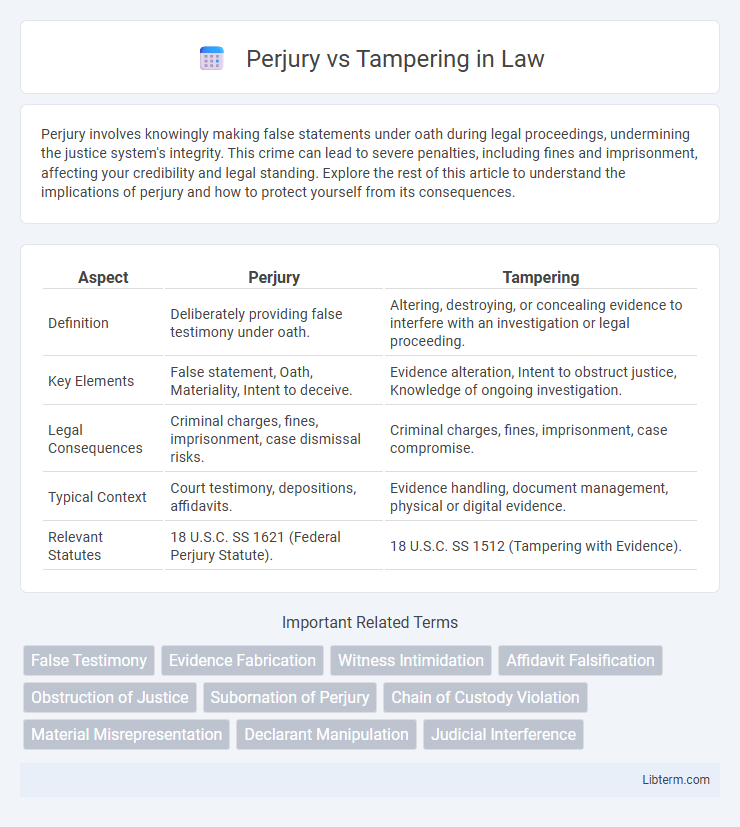Perjury involves knowingly making false statements under oath during legal proceedings, undermining the justice system's integrity. This crime can lead to severe penalties, including fines and imprisonment, affecting your credibility and legal standing. Explore the rest of this article to understand the implications of perjury and how to protect yourself from its consequences.
Table of Comparison
| Aspect | Perjury | Tampering |
|---|---|---|
| Definition | Deliberately providing false testimony under oath. | Altering, destroying, or concealing evidence to interfere with an investigation or legal proceeding. |
| Key Elements | False statement, Oath, Materiality, Intent to deceive. | Evidence alteration, Intent to obstruct justice, Knowledge of ongoing investigation. |
| Legal Consequences | Criminal charges, fines, imprisonment, case dismissal risks. | Criminal charges, fines, imprisonment, case compromise. |
| Typical Context | Court testimony, depositions, affidavits. | Evidence handling, document management, physical or digital evidence. |
| Relevant Statutes | 18 U.S.C. SS 1621 (Federal Perjury Statute). | 18 U.S.C. SS 1512 (Tampering with Evidence). |
Understanding Perjury: Definition and Implications
Perjury involves deliberately making false statements under oath during legal proceedings, undermining the integrity of the judicial system. It carries severe legal consequences, including fines and imprisonment, as it disrupts the pursuit of truth in court cases. Understanding perjury is crucial for recognizing its impact on justice and the importance of truthful testimony in legal settings.
What Constitutes Tampering: Legal Overview
Tampering involves the intentional alteration, destruction, or concealment of evidence relevant to an investigation or legal proceeding, aiming to obstruct justice. It includes actions such as falsifying documents, destroying physical evidence, or influencing witnesses to provide false testimony. Legal statutes classify tampering as a serious offense, often resulting in criminal charges that carry substantial penalties including fines and imprisonment.
Key Differences Between Perjury and Tampering
Perjury involves knowingly making false statements under oath during legal proceedings, directly impacting the integrity of testimony, while tampering refers to unlawfully altering, destroying, or concealing evidence to obstruct justice. Key differences include their focus: perjury targets the verbal dishonesty of a witness, whereas tampering concerns physical interference with evidence or influencing witnesses. Both crimes undermine legal processes but vary in method and the type of obstruction they represent in judicial investigations.
Elements Required to Prove Perjury
Proving perjury requires establishing that the defendant made a knowingly false statement under oath, with the intent to mislead the court or legal proceeding. The statement must be material, directly affecting the outcome of the case, and the individual must have been aware of the truth at the time of the declaration. Unlike tampering, which involves altering or fabricating evidence, perjury centers explicitly on false testimony given during judicial processes.
Elements Required to Prove Tampering
Tampering requires proving the intentional alteration, destruction, or concealment of evidence to obstruct justice, focusing on the defendant's knowledge and specific actions to interfere with the legal process. Evidence must demonstrate that the accused acted with the purpose of misleading an investigation or trial, such as falsifying documents or destroying physical proof. The burden lies on establishing both the act of tampering and the corrupt intent behind it to differentiate from accidental or unrelated conduct.
Common Examples of Perjury in Legal Proceedings
Common examples of perjury in legal proceedings include intentionally providing false testimony under oath, falsifying affidavits or sworn statements, and denying knowledge of facts previously admitted. Witnesses may commit perjury by fabricating evidence or lying about events to influence the trial's outcome. These acts undermine the judicial process by obstructing the truth and swaying verdicts based on deceit rather than facts.
Common Forms of Evidence Tampering
Common forms of evidence tampering include altering, destroying, or fabricating physical or digital evidence to mislead investigations. Examples encompass erasing or modifying electronic records, contaminating crime scenes, and falsifying documents or witness statements. Such actions obstruct justice by compromising the integrity of evidence essential for proving perjury or other criminal offenses.
Penalties and Consequences: Perjury vs. Tampering
Perjury, the act of knowingly providing false testimony under oath, carries severe penalties including fines, imprisonment up to five years, and potential disbarment for legal professionals. Tampering, which involves altering, destroying, or concealing evidence, can result in penalties such as imprisonment ranging from one to ten years depending on jurisdiction, along with hefty fines and probation. Both offenses significantly damage judicial integrity, leading to long-term consequences like criminal records, loss of professional licenses, and diminished credibility in future legal matters.
Preventing Perjury and Tampering: Best Practices
Preventing perjury and tampering requires strict adherence to legal integrity and transparent processes in judicial and investigative settings. Implementing comprehensive witness education programs, maintaining secure evidence handling protocols, and conducting regular audits significantly reduce the risk of false statements and evidence manipulation. Legal professionals must enforce stringent penalties and foster a culture of accountability to deter attempts at perjury and tampering effectively.
Legal Defenses Against Charges of Perjury or Tampering
Legal defenses against perjury charges often involve proving the statement in question was true, made without intent to deceive, or constituted opinion rather than fact. In tampering cases, defenses may include demonstrating lack of knowledge, absence of intent to alter evidence, or proving the evidence was not actually modified or destroyed. Effective legal strategies require meticulous examination of the prosecution's evidence and establishing reasonable doubt about the defendant's intent or actions.
Perjury Infographic

 libterm.com
libterm.com